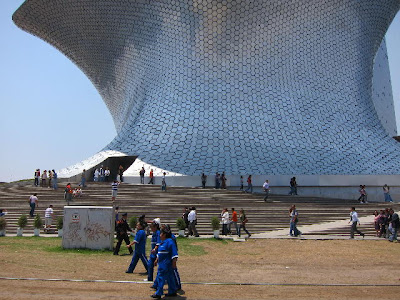
Roberto Jacoby at El Parrillon, la mejor y mas grande bondiola, at La Costanera, Buenos Aires.




informal sellers and performers at La Costanera, glass and steel mini Manhattan of Buenos Aires in the background.
On Saturday I went for a 5 PM stroll with artist Roberto Jacoby to the Costanera of Buenos Aires. The Costanera used to be the river coast of Buenos Aires with the Rio de la Plata (I love the translation of River Plate), although located next to the river/sea, and having been an important port for centuries, Buenos Aires is a city that turns it's back to it's sea. The old port area has been developed and gentrified in the past 15 years with its transformation into Puerto Madero, an elite residential, office and leisure area similar to many other apartheid luxury developments in cities worldwide. Next to it, La Reserva Ecologica and the paseo de La Costanera co-exist, and allow for much more democratic urban leisure spaces.
Our first stop was an attempt to visit the Museo de Calcas (which keeps copies of classical sculptures), which was closed for renovation. We then passed the police car-cemetery and visited the Villa Rodrigo Bueno, an illegal settlement (read favela) inhabited by Bolivian, Paraguayan and Peruvian immigrants. Our next stop, next to la villa, was la Reserva Ecologica, a stretch of land gained to the river during the 70s and 80s, made out of dumping the demolition material from the city into the river, with the original plan of building a new political-administrative centre for the city during the dictatorship. The plan never happened and the river covered the dump with soil, seeds and vegetation, which also prompted the return of fauna, and what developed is what is now the Ecological Reserve (which also happens to be one of the traditional homosexual cruising grounds). We continued walking down la Costanera, in what used to be the traditional 1910-1920s river promenade and resort where the working classes would come to bath, and which was later abandoned in the 50s-60s due to the river's pollution. La Costanera is again today a pleasant river walk (although the river is not there anymore, with La Reserva Ecologica creating a buffer between La Costanera and El Rio de la Plata), which is invaded by informal sellers, food posts, and performers. One cross dressed Paraguayan performance was singing songs from Amanda Miguel, an Argentinean singer from the late 70s and 80s who was exiled in Mexico during the dictatorship and who with her husband Diego Verdaguer became pop famous there, being almost unknown even today in Argentina.
During the walk with Roberto we talked about the immigrant history of Buenos Aires, and its more recent Latino Americanisation trough South American immigration. We also talked amongst many other things about artistic and sexual survival during the times of the dictatorship, the antifetichisation of his most recent retrospective, and the songs he wrote for rock band Virus in the 80s.
Born in 1944, Roberto Jacoby is probably Argentina's most interesting living contemporary artist. He recently had a brilliant
retrospective at Reina Sofia in Spain, and produced the polemical
artistic support brigade in support of Dilma's candidature for the presidency in the last Sao Paulo Biennal. With Judi Werthein and Graciela Hasper he is also one of the instigator's of
CIA, Centro de Investigaciones Artisticas in Buenos Aires. Active since the late 60s (he participated in Tucuman Arde, as well as part of the generacion de Di Tella), Roberto has been instrumental in supporting the younger generation of artists, specially that coming out of the 2001 Argentinean economic crisis through projects such as
Proyecto Venus,
Ramona magazine,
Bola de Nieve (a web archive of argentinean artists) and more recently
CIA.






















































